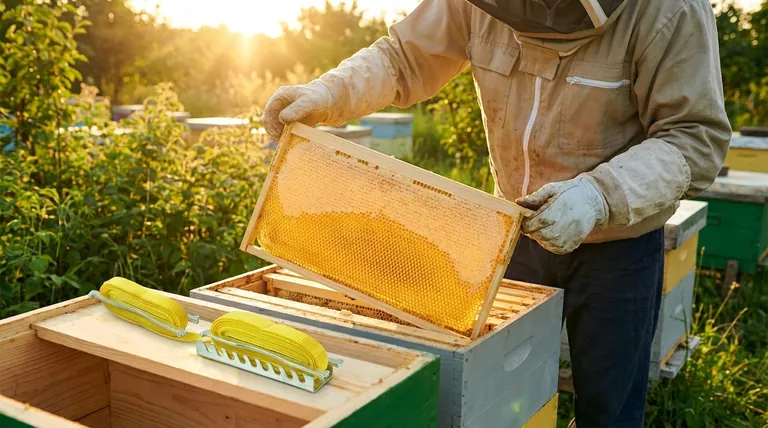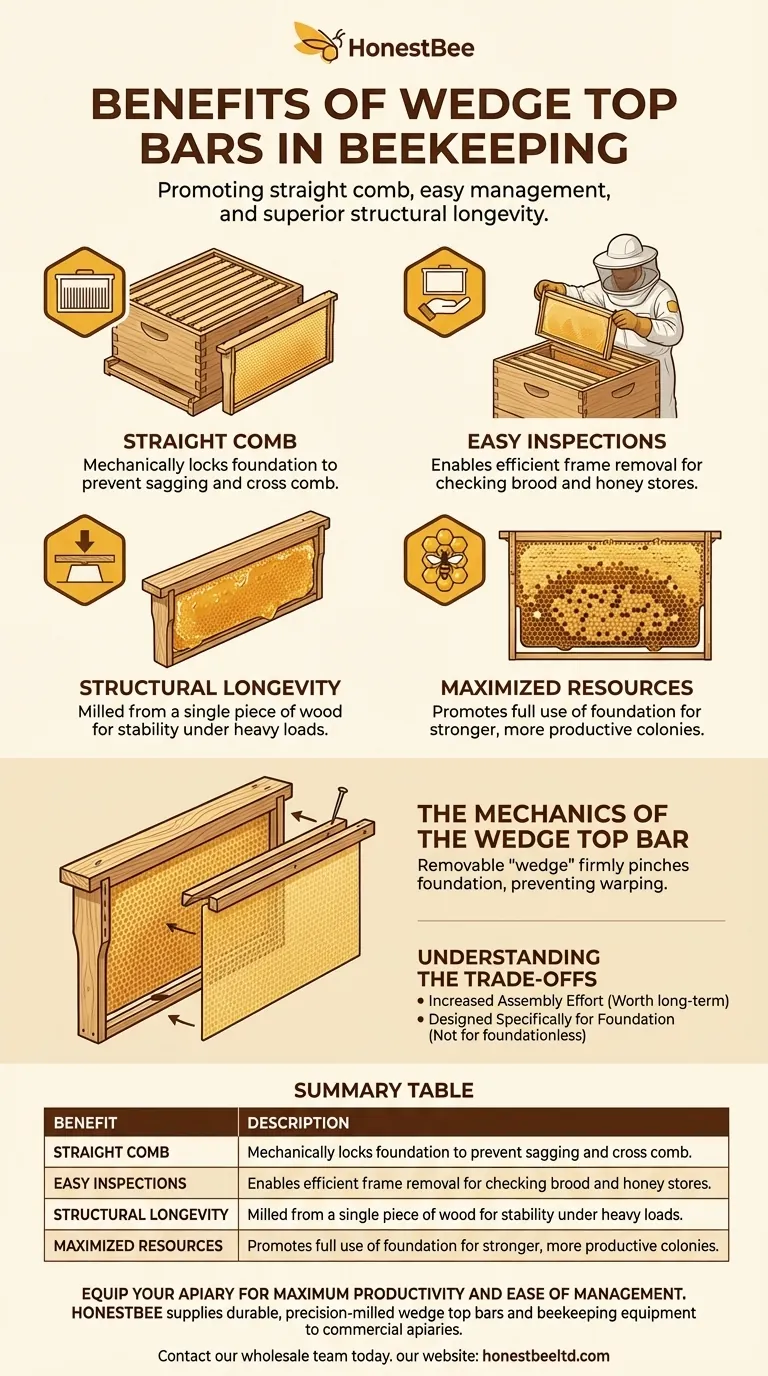In beekeeping, the benefits of wedge top bars are significant: they are specifically designed to promote the construction of straight, easily manageable comb and provide superior structural longevity. Because they are typically milled from a single, solid piece of wood, they create a highly stable frame that securely anchors the foundation, preventing sagging and warping over time.
The core challenge for any beekeeper is guiding bees to build orderly comb within the frames. A wedge top bar is the most effective design for this because it mechanically locks the foundation sheet in place, ensuring a straight start and creating a durable frame that withstands years of use.

Why Straight Comb is the Beekeeper's Goal
The entire practice of modern beekeeping relies on the ability to remove and inspect individual frames. The design of your frames directly influences how easily this can be done.
Preventing Cross Comb
Bees, if left without clear guidance, will often build comb that connects multiple frames together, known as cross comb or burr comb. This makes it impossible to pull a single frame without ripping apart honeycomb, destroying brood, and angering the colony.
Simplifying Hive Inspections
Straight comb, built neatly within the confines of a single frame, allows a beekeeper to perform inspections efficiently. You can remove one frame at a time to check the queen's laying pattern, look for signs of disease, and assess honey stores with minimal disruption to the hive.
Maximizing Hive Resources
When bees build straight, they utilize the entire surface area of the foundation provided. This leads to more space for raising brood and storing honey, resulting in a stronger and more productive colony.
The Mechanics of the Wedge Top Bar
The effectiveness of the wedge top bar comes from its simple yet brilliant mechanical design. It is not just a piece of wood; it is a system for securing foundation.
How the "Wedge" Works
A wedge top bar features a small, removable strip of wood (the "wedge") on its underside. To assemble the frame, you place your sheet of wax or plastic foundation into the groove, then press the wedge back into place and secure it with small nails.
This action firmly pinches the foundation along its entire top edge. This secure anchor is the single most important factor in preventing foundation from sagging or warping, which is the primary cause of crooked comb.
Single-Piece Design for Stability
Unlike frames that require gluing or stapling multiple pieces to form the top bar, a wedge top bar is milled from a single, solid piece of wood. The top bar bears the most weight in a frame, especially when full of honey.
This one-piece construction eliminates weak points, ensuring the frame remains rigid and stable for many years, even under the stress of repeated inspections and extractions.
Understanding the Trade-offs
While highly effective, wedge top bars are not without their considerations. Objectivity requires acknowledging where they might not be the perfect fit for every situation.
Increased Assembly Effort
The process of inserting foundation and nailing the wedge requires slightly more time and care during assembly compared to a "grooved" top bar, where you simply slide the foundation in. However, this initial time investment pays dividends in long-term hive manageability.
Designed Specifically for Foundation
The primary advantage of a wedge top bar is its ability to secure a full sheet of foundation. If you practice foundationless beekeeping, where you only provide a small starter strip to guide the bees, the wedge design is unnecessary and other frame types with a simple comb guide may be more suitable.
Making the Right Choice for Your Frames
Your choice of frame components should align directly with your beekeeping goals and management style.
- If your primary focus is long-term reliability and ease of inspection: The wedge top bar is the definitive choice for use with wax or plastic foundation.
- If your primary focus is the absolute fastest assembly: A grooved top bar is quicker to build but risks foundation sag over time, potentially leading to future problems.
- If your primary focus is foundationless beekeeping: A frame with a simple, built-in comb guide is a more direct and effective solution than a wedge top bar.
Ultimately, selecting the right equipment is the first step toward building a healthy, productive, and manageable apiary.
Summary Table:
| Benefit | Description |
|---|---|
| Straight Comb | Mechanically locks foundation to prevent sagging and cross comb. |
| Easy Inspections | Enables efficient frame removal for checking brood and honey stores. |
| Structural Longevity | Milled from a single piece of wood for stability under heavy loads. |
| Maximized Resources | Promotes full use of foundation for stronger, more productive colonies. |
Equip your apiary for maximum productivity and ease of management. HONESTBEE supplies durable, precision-milled wedge top bars and beekeeping equipment to commercial apiaries and distributors through wholesale-focused operations. Our frames are built for the rigors of commercial use, ensuring your hives remain manageable and productive season after season. Contact our wholesale team today to discuss your equipment needs and volume pricing.
Visual Guide

Related Products
- Professional Galvanized Hive Strap with Secure Locking Buckle for Beekeeping
- HONESTBEE Bee Frame Grooving Machine | Precision Slotting for Bee Frame Making
- Professional Engraved Round Hive Number Tags for Beekeeping
- Beehive Entrance Discs Plastic Bee Entrance Disc for Bee Hives
- Multi-Functional Rotary Hive Entrance Disc for Beekeeping
People Also Ask
- What is the advantage of using cam buckle straps? Secure Your Load Fast with Simple, Safe Tensioning
- What are the two styles of hive straps? Choose the Right Strap for Your Hive Security
- How can beekeepers secure the top cover of a hive? Protect Your Colony from Wind and Weather
- Why are hive straps important for beekeepers? Secure Your Hives Against Wind, Predators & Transport
- What maintenance is required for hive straps? A Guide to Cam Buckle vs. Ratchet Strap Care



















